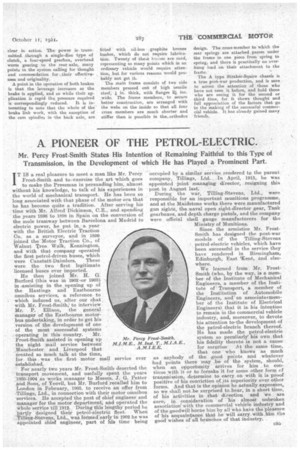IMPROVING THE POST-WAR STRAKER-SQUIRE.
Page 44

Page 45

If you've noticed an error in this article please click here to report it so we can fix it.
A Vehicle with Much Originality in Its Design is Altered in a Few of Its Features.
MEE 1922 A type Straker-Squire chas sis, whilst employing all the salient features of the poet-war model, has in some respects been redesigned and improved upon. The design in many details is original, and the fact. that the chassis has given such universal satisfaction in the hands of corporations, contractors and private users, both as passenger and commerce-carrying vehicles in this country and overseas, fully justifies the bold step the manufacturers took in placing' such an advanced machine on the market.
The position of. the dashboard and driver allowof approximately two feet more body space than if standard design had been followed, and consequently a better distribution of load over the two axles ; in fact., with a 14 ft. 6 in. wheelbase, a body space of 17 ft. 8i ins is obtained. Thus, a 54-seater double. deck or. 34-seater single-deck omnibus or char-'a-bancs body can be accommodated without undue overhang or overloading of the back axle.
The latest design engine rear cover is hinged on the dashboard, and can be raised by the undoing of two clamping wing nuts. Through this opening access to most of the valves and plugs can be obtained, the remainder -being easily reached by the removal of the bonnet side.
The springing of the chassis is a point which calls for special mention. The ordinary type of spring shackles are dispensed with, and a special type, in which hardened steel balls work in chilled iron cups, is employed for the front ends of the rear springs and the rear ends of the front springs. The other ends of these springs are provided with cast-iron slides, working on hardened steel balls and enclosed in slipper boxes, which. _permit 1 in, of lateral movement in each direction, so that the usual twisting strains shall not be transmitted to the Main frame.
The springs !afe massive, the front being 4 ft. • 3 ins, long by 24 ins. wide and the rear 5 ft. 6 ins, long by 4 inswide—the latter are underslung. Particular care has been taken in the design to ensure the springing being equally effective dor light and heavy loads by providing additional coil auxiliary springs at the rear which, when the vehicle carries its full load, take 25 per cent, thereof, and go right out of action when the vehicle is running light. Auxiliary coil springs are also provided in the same way to the front springs.
Much consideration has been given to that important unit the steering gear. The column is well raked, and the wheel is 20 ins, diameter, and' with the excellent springing of the front of the chassis the driver's work is light as compared with that on other vehicles. The machine can be turned in a 53 ft.-circle.
It is unnecessary here to give details of the various units comprising the chassis because they were given in extenso in The Commercial Motor when the vehicle was first produced. Suffice it under these heads to say that the engine and gearbox are carried on a sub-frame, the members of which are machined so as to secure accurate alignment of those two components. The whole power unit can be readily removed from the frames, or, if it be the clutch that calls for attention, the extensions of the sub-frame members beyond the end of the gearbox permit that. unit to be moved back without the necessity for its removal from the frame.
The engine is four-cylindered, 41 in. bore and 61 in. stroke, and developing 55 b.h.p. at 1,000 r.p.m. It has a nunsher of very nice details, not the least interesting of which is the valve rocker arm gear, which is simple, effective and clear in action. The power istransmitted through a single-disc type of clutch, a four speed gearbox, overhead worm gearing to the rear axle, many points in the system calling for thought and commendation for .,their effectiveness and originality.
A point in the operation of both brakes is that the leverage increases as the brake is applied, and so while their application is rapid the pressure required
is correspondingly reduced. It is interesting to note that the whole of the brake link work, with the exception of the cam spindles in the back axle, are
fitted with oil-less :graphite bronze bushes, which do not require lubrication. Twenty of the-•ali Fleshes are used, representing as many points which in an ordinary vehicle would require attention, but for various reasons would probably not get it.
The main frame consists of two side members pressed out of high tensile steel, k in thick, with flanges 21 ins. wide. The frame members, to secure better construction, are arranged with the webs on the inside so that all four cross members are much shorter and stiffer than is possible in the..orthodox
design. The cross-member to which the rear springs are attached passes under the frame in one piece from spring to spring, and there is practically no overhung load :on their attachment to the frarhe. •
The A type Straker-Squire chassis is a true post-war production, and is sure to arrest the attention. of those who have not seen, it before, and hold those who are seeing it for the second or third trifle, for, it shows thought and full appreciation of the factors that go to the making of the successful commercial vehicle. It has already gained many, friends.




















































